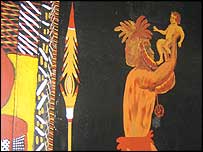
The first type of marriage was known to be a betrothal marriage. A father would arrange the marriage of his daughter before or prior to her birth. He would primarily target a man no younger than twenty-five years old. At that age, a man was seen to have fully established himself with wealth, and therefore, would be seen as a suitable husband (C. W. M. Hart et al: 1988, 20). The daughter would grow up to about fourteen years old before she was married off to her husband, who by that time would be around the age of forty. Looking into another article, “The Tiwi practice of bestowing result[ed] in large age differences between a wife and her husband. They [were] almost never less than 25 years apart” (Paul Wren: 2005). By bestowing his daughter, a father granted a man her responsibility, yet overlooking the age difference. This overlooked concept went to show the hardships faced by women with husbands who stood to be much older. Looking closely, by the time a young wife was fully capable of nurturing children and taking care of the household (at about age 25), her husband was close to, or far beyond the age of fifty, perhaps in the state of dieing because of a low survival rate for men in the older days. This would lead to the second type of marriage.
The second type of marriage was known to be a widow remarriage. This type of marriage was usually arranged by the son of a mother, after her husband had passed away. Since the Tiwi people stood to be a patrilineal society, if it wasn’t the son, then the brother of the widow would take over the responsibility of her remarriage. This is when younger men around the age of twenty-five were tracked down. Since many waited for their betrothed wives to grow, they married widows in the mean time to start a family of their own, earning wealth earlier (C. W. M. Hart et al: 1988, 33). As one can see, the age difference was not considered even during a remarriage of a widow. Young men were seen to seek popularity by marrying the most amount of women as if it stood to be a contest. Since the younger wives were too young, young men seeked popularity amongst elder women. In relation to men, women were seen to remarry because the Tiwi believed that females needed to have a husband at all times, being able to be impregnated at any time. Studying the Ju/’hoansi in comparison to the Tiwi people, Paul Wren in 2005 stated, “The Tiwi [were] perhaps the most polygynous culture in the world. Tiwi men [began] collecting wives in their late twenties and those who [were] successful add[ed] wives up until the time of their death. The first wives acquired by Tiwi men [were] usually post-menopausal widows. If young men [were] perceived as "up and coming" and might add prestige or power as a son-in-law, fathers [would] bestow their infant daughters to them as wives. The most successful Tiwi men have been known to have twenty wives.
As one can see, men were considered to be more powerful by the number of wives they “captured”, so to speak. Therefore, once the first “crop” was established by an elder woman (most likely a widow who remarried), the younger wife would be old enough to continue the dynasty of the husband (C. W. M. Hart et al: 1988, 20). Women were referred to as “crops” that, like a tree, grew, gave apples to men, and provided shade. Once they were old, new “crops”, or trees (women to be precise), were brought into the dynasty and the pattern continued. By any means, no female was left behind without a man. Whether a female was a newborn baby or a widow of a much older man, a husband was chosen to provide for her.
Therefore, due to these two types of marriages in society, the Tiwi society was the only society with an illegitimacy rate of zero” (C.W. M.:1988, 18).